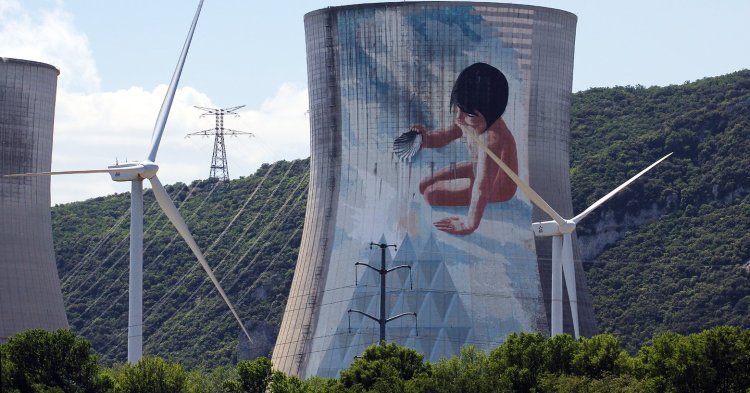30 years after reactor accident in Chernobyl nuclear power is still one of the most important energy sources in Europe and the world. Neither mass protests since the 1970’s nor the disaster in Fukushima resulted in stopping energy generation from nuclear power. But energy landscape and attitude to different energy sources is changing in the last years.
The accidents in Fukushima and Chernobyl illustrated how vulnerable those power plants everywhere in the world are. Causes of these catastrophes can be technical or construction defects or human failure or natural disasters like tsunamis or earthquakes. Many reactors in Europe are classified as at risk. Just as little all causes of reactor accidents can be prevented as hard it is to repair the damages of a GAU. In both accidents all clear-up and dismantling operations are not finished, even not in Ukraine after 30 years.
Further causes of nuclear accidents
Further causes for nuclear accidents are less considered. More and more new forms of Islamist terrorism threaten the security of nuclear power plants in Europe. Being a worthy objective of hijacked planes is only one possible variant. In the environment of the latest terror attacks in Europe irregularities became known about a nuclear scientist and the Belgian power plants Doel and Tihange: Over three years a jihadist trained in Syria worked at the plant in Doel, a terrorist of the Paris attacks spied on the head of the nuclear power research centre.
In April 2016 German media reported on a computer virus which were discovered in the computer systems of the German nuclear power plant Gundremmingen. Even though no concrete consequences on the security could be identified so far this case shows the vulnerability of those systems. Terrorists can gain access to sensible areas and do damage through infiltrating the staff or the computer systems.
Especially the potential damage is enormous. Many European nuclear power plants are situated in densely populated areas und previous accidents show how difficult it is to stop a GAU. Millions of people could be affected by nuclear accidents or terroristic attacks on power plants in Europe.

No end in sight?
Besides all these dangers the problem of nuclear waste disposal remains. Still to the present day no final repository in the world could be found. But the steady growing mountain of waste threaten the health of the people and the environment. A nuclear phaseout seems to be the only logical step to a cleaner and safer world. But it’s not that easy to change the attitude.
The worldwide growing hunger for energy especially in developing and emerging countries consume more and more resources. Even in countries with the highest level of newly installed renewable energies like China, USA and Japan their energy systems are dependent on traditional energy sources like coal, oil and nuclear power. The Paris Agreement of reduction of CO2 emissions led to a worldwide boom of new built nuclear power plants. They are regarded as climate neutral and help to save the CO2 balance and simultaneously satisfy the energy demand.
Europe as a role model
Besides these negative news stories for the anti-nuclear movement there is still some hope that just politics and economy in Europe can agree on a comprehensive restructuring of the energy system. Europe’s supply network is broadly extended and even more power highways between the member states shall connect the national power grids. This strategy is pushed as theenergy union by the EU commission.
With these technical conditions and the political will towards a renewable energy system the nuclear phase out can be achieved for a whole continent and become a role model for other regions as well.
Resistance in the national states
So far it’s mainly the national governments who fight against the end of nuclear power in Europe. France argues that its historically grown grid with 19 nuclear power plants can’t be change from one day to another. However, Germany – comparable in population and economic power – is phasing out completely by 2022.
Also in smaller countries like Czech Republic, Slovakia or the Baltic countries nuclear power plays an important role in their energy mix. So their governments argue that a system conversion to renewables would be too costly for economic reasons. Furthermore, the social support in these countries for energy from wind and sun is missing.
A gap appears
Only some of the smaller EU countries can do without nuclear power. Denmark with its high share of wind energy is a shining example which not many countries can achieve. But a different aspect is giving hope for a change. Nuclear power plants in Europe have a defined maximum operating period after which the plants have to be shut down. The dates for the shutdowns are already available for almost all plants.
This will allow to better plan the conversion. Since governments and EU commission know when new energy capacities will be demanded because a plant needs to be shut down renewable energies could be funded more aimed and integrated in the next 20 or 30 years.
By 2045 nuclear power plants with a capacity of 125 gigawatt will be shut down, a majority of it already by 2030 (see chart). This is slightly more than renewables in Europe today. So solely with an exchange of the nuclear power with renewables after their regular operating period could double the share of renewable energies.





Follow the comments: |
|
